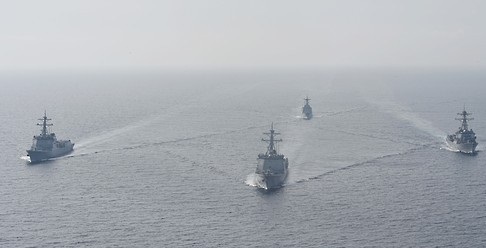South Korea, US, Japan kick off missile warning drill
By Yeo Jun-sukPublished : Oct. 24, 2017 - 16:43
South Korea, the United States and Japan on Tuesday began a two-day missile warning drill to better detect and track incoming missiles in the event of a possible North Korean attack.
According to Seoul’s Joint Chiefs of Staff, the joint military exercise took place in waters off the coasts of South Korea and Japan. Included in the drill were the Aegis destroyer Yulgok Yii of South Korea, the USS Stethem and USS Decatur Aegis destroyers from the US, and a JDS Kirishima destroyer from Japan.
The drill largely focused on having the warships detect and track an incoming missile via radar in a computer-simulated scenario. The scenario, however, did not include the process for intercepting a mock target, said the JCS.
“The exercise is limited to a detection and tracking drill,” said JCS spokesman Col. Roh Jae-chun in a regular press briefing. “When it comes to the timing of the exercise, we chose the best time when South Korea, the US and Japan assets can participate.”

Designed to counter North Korea’s escalating nuclear and missile threats, the drill was decided upon at the conclusion of the 48th Security Consultative Meeting between the US and South Korea in October 2016, the JCS added.
The exercise is the first joint missile warning drill since North Korea fired off a ballistic missile over the northern Japanese island of Hokkaido before landing in the Pacific Ocean on Sept. 15. Beforehand, the exercise had been taking place every few months since June last year.
During a trilateral meeting in the Philippines on Monday, South Korea’s Defense Minister Song Yong-moo, his US counterpart Jim Mattis and Japanese counterpart Itsunori Onodera pledged to continue the joint exercise.
Meanwhile, an opposition lawmaker said Tuesday that when North Korea fired ballistic missiles into the waters between South Korea and Japan, it took much more time for Seoul than Tokyo to respond and send warnings to fishing vessels.
Citing Korea Coast Guard data since July last year, Rep. Lee Koon-hyon of the Liberty Korea Party said it took an average of about 41 minutes for the fishing vessels to receive warnings of a North Korean missile launch and take shelter.
For instance, when the North fired its latest ballistic missile on Sept. 15, it took about 33 minutes for the warnings to be delivered to the vessels. On the other hand, it took only three minutes for the Japanese early warning system, known as J-alert, to disseminate the warning, the lawmaker said.
“Our government and coast guard have been too complacent in responding to North Korea’s ballistic missiles launches,” Lee said in a statement. “Japan has done its utmost to ensure public safety. We have to overhaul the early warning system to protect our people and sailors.”
By Yeo Jun-suk (jasonyeo@heraldcorp.com)












![[Today’s K-pop] BTS pop-up event to come to Seoul](http://res.heraldm.com/phpwas/restmb_idxmake.php?idx=644&simg=/content/image/2024/04/17/20240417050734_0.jpg&u=)




![[KH Explains] Hyundai's full hybrid edge to pay off amid slow transition to pure EVs](http://res.heraldm.com/phpwas/restmb_idxmake.php?idx=652&simg=/content/image/2024/04/18/20240418050645_0.jpg&u=20240418181020)

![[Today’s K-pop] Zico drops snippet of collaboration with Jennie](http://res.heraldm.com/phpwas/restmb_idxmake.php?idx=642&simg=/content/image/2024/04/18/20240418050702_0.jpg&u=)